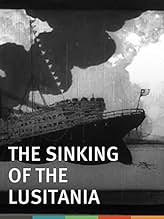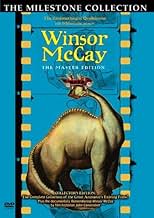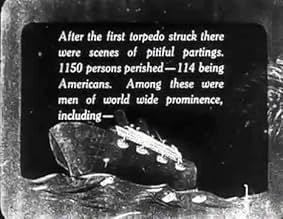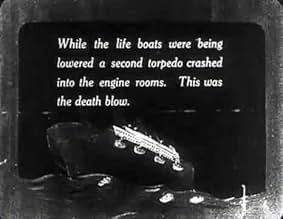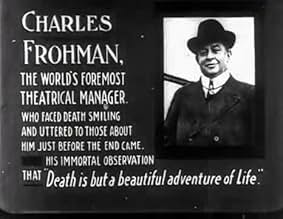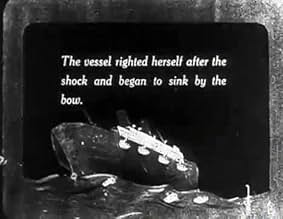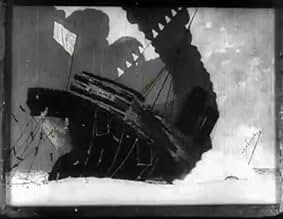IMDb RATING
6.8/10
1.3K
YOUR RATING
An animated dramatization of the notorious World War I German torpedoing of the ocean liner, Lusitania.An animated dramatization of the notorious World War I German torpedoing of the ocean liner, Lusitania.An animated dramatization of the notorious World War I German torpedoing of the ocean liner, Lusitania.
- Director
- Writer
- Star
- Awards
- 1 win total
- Director
- Writer
- All cast & crew
- Production, box office & more at IMDbPro
Featured reviews
10Woody-61
Although Winsor McCay is primarily known for such whimsical flights of fantasy as "Gertie the Dinosaur" and the comic strip "Little Nemo in Slumberland", this recreation of the great ocean-liner tragedy is just as remarkable. Painstakingly realistic, the graphic detail and fluidity of motion in this cartoon are far ahead of their time. This was actually the first film to use cel animation, as the amount of detail McCay envisioned would have made drawing each picture individually near impossible. In fact, you really have to look closely at the human figures to tell that it isn't actual live footage. The torpedoes striking the hull, the subsequent explosions, the lifeboats and ropes flying over the sides, the passengers jumping overboard, the attempts at rescue, and the tragic fates of those unfortunates adrift in the ocean are all wonderfully and harrowingly realised. That the quality of this film isn't in the greatest condition anymore (at least the print of it I saw wasn't) somehow only makes it feel even more authentic. The final shot packs an emotional wallop infinitely greater than anything in Cameron's TITANIC.
America had entered the war by the time Winsor McCay released this film. The sinking of the Lusitania, which carried munitions as well, swayed American sentiment, but not until Germany retracted its guarantee of not repeating the tragedy, among other issues of course, did the US ally. McCay's masterpiece was surely as worthy propaganda as posters, as there was still fight to last a few more months.
By 1918, the celluloid animation process had been invented. John Fitzsimmons and Apthorp Adams providing such as the waves with less monotony to the task, and McCay is supposed still to have created some 25,000 drawings for the production. As he had done with previous shorts, McCay produced a live-action introduction promoting his dedication and hard work. His last film, "Gertie the Dinosaur", drawn on rice paper before the advent of cel animation, was the most accomplished work of animation to date. Yet, with a cliché not to be used lightly, "The Sinking of the Lusitania" was ahead of its time--years before the assembly lines of animation studios would attain such splendor. Where Gertie was a likable, coy cartoon--one of the first personated characters in animation, this short is a moving tragedy transcending to likeness re live-action.
It likens a subjective docudrama styled as a propaganda newsreel. It contains shots impossible to have covered, impossible to have recreated in a live-action film as of then, although probably thought impossible to create in animation until McCay did it. The framing and positioning is apt, the detail meticulous. There was little need for me to screen this film again before writing this comment; images of the ocean liner steaming past the Statue of Liberty, floral smoke arising from the torpedo hits, rhapsodic falling bodies, bobbing heads and the isolated sinking in the final shot to punctuate the event, I'll always remember.
By 1918, the celluloid animation process had been invented. John Fitzsimmons and Apthorp Adams providing such as the waves with less monotony to the task, and McCay is supposed still to have created some 25,000 drawings for the production. As he had done with previous shorts, McCay produced a live-action introduction promoting his dedication and hard work. His last film, "Gertie the Dinosaur", drawn on rice paper before the advent of cel animation, was the most accomplished work of animation to date. Yet, with a cliché not to be used lightly, "The Sinking of the Lusitania" was ahead of its time--years before the assembly lines of animation studios would attain such splendor. Where Gertie was a likable, coy cartoon--one of the first personated characters in animation, this short is a moving tragedy transcending to likeness re live-action.
It likens a subjective docudrama styled as a propaganda newsreel. It contains shots impossible to have covered, impossible to have recreated in a live-action film as of then, although probably thought impossible to create in animation until McCay did it. The framing and positioning is apt, the detail meticulous. There was little need for me to screen this film again before writing this comment; images of the ocean liner steaming past the Statue of Liberty, floral smoke arising from the torpedo hits, rhapsodic falling bodies, bobbing heads and the isolated sinking in the final shot to punctuate the event, I'll always remember.
From Winsor McCay, the revolutionary animation pioneer and director of the charming classic "Gertie the Dinosaur" comes a much darker animated tale. This film recounts the tragic striking and sinking of the Lusitania which took away over 1000 lives. This film is highly respectful in execution, and it certainly isn't what you would expect from McCay, who normally crafted extremely funny and enjoyable animations rather than heartbreaking dramas. But, although its execution is much different than any other silent drama on the subject could be, it is highly effective and powerful, not to mention well made! The animation is wonderfully done, and doesn't look too "cartoony" for the depressing subject matter. McCay creates haunting and slightly propagandic images with this invention, images that wouldn't have been successfully captured on a 1918 movie set.
Animation historians must view this film immediately, but I suppose if you can find one McCay cartoon you can find them all - they're compiled on the 'Animation Legend' video and DVD. 'Lusitania' is the film where McCay tries to escape the caricatural confines of the animated picture to produce a serious and moving film, and damn, he succeeds. The meticulous care which he put into the thousands of drawings necessary for this short cartoon meant that by the time it was finished, it was barely topical and WWI was over, leaving its calls for vengeance somewhat stranded. However, as a study of technique it is perhaps unsurpassed. McCay's animation has a dimensionality which is worlds apart from the character animation of Koko the Klown or Felix the Cat, perhaps a deliberate differentiation from such gentle entertainments. The grim monochrome images of the Lusitania's stern raised in the air while hundreds of people leap to their deaths while remind most audiences of shots from James Cameron's 'Titanic'. While the barely-concealed rage and maudlin tributes to the famous noblemen who died in the sinking (as opposed the penniless plebs who we can afford to forget) now appear unpalatably heavy-handed, the elegant curls of smoke from the stricken vessel are simply powerful cinematic touches which seal McCay's reputation as one of the great film artists of the silent era. If only he, and not Disney, had become the template for the future of American animation...
Premiering almost three years to the month of the German submarine attack on a passenger ship, Winsor McCay's laborious effort to bring a dramatic slant to one of the United States' momentus events during the second year of the Great War resulted in the groundbreaking animated cartoon May 1918's "The Sinking of the Lusitania." The 12-minute film was not only the longest animation up to that time, but is the earliest surviving cartoon of a serious and dramatic nature.
McCay, an editorial cartoonist for the William Randolph Hearst newspaper chain, was a animated hobbyist in his spare time. He was bothered by Hearst's demands that he draw only anti-war, anti-British cartoons since the publisher was an ardent isolationist ever since the war began in 1914. The German submarine attack on the British ocean liner Lusitania carrying American passengers on May 7, 1915, especially rankled McCay, sparking a project of illustrating the sinking in animated form.
For 22 months, he along with two other illustrators composed over 25,000 drawings in their spare time and using McCay's own money. The trio used the fairly new animated technology of cel animation, using sheets of cellulose acetate to draw the movements of the ship and sub while retaining the static layer underneath, the first time McCay had ever used the process. Despite the time-saving operation, the moving cartoon still took an inordinate amount of time to create. To produce eight seconds of film, McCay claimed it took eight weeks to draw and film.
Jewel Productions, a film distribution company, paid the highest price at that time for a one-reeler for its rights. The company claimed the cartoon was "the world's only record of the crime that shocked humanity" since there weren't any cameras on board the Lusitania to record the torpedo hits. The propaganda value when it was shown during the summer of 1918, although emotional, was limited since American troops were already heavily involved in the European battles. But the "Lusitania" would serve as an example to the effectiveness in using animation for propaganda purposes, especially when World War Two rolled around 25 years later.
McCay, an editorial cartoonist for the William Randolph Hearst newspaper chain, was a animated hobbyist in his spare time. He was bothered by Hearst's demands that he draw only anti-war, anti-British cartoons since the publisher was an ardent isolationist ever since the war began in 1914. The German submarine attack on the British ocean liner Lusitania carrying American passengers on May 7, 1915, especially rankled McCay, sparking a project of illustrating the sinking in animated form.
For 22 months, he along with two other illustrators composed over 25,000 drawings in their spare time and using McCay's own money. The trio used the fairly new animated technology of cel animation, using sheets of cellulose acetate to draw the movements of the ship and sub while retaining the static layer underneath, the first time McCay had ever used the process. Despite the time-saving operation, the moving cartoon still took an inordinate amount of time to create. To produce eight seconds of film, McCay claimed it took eight weeks to draw and film.
Jewel Productions, a film distribution company, paid the highest price at that time for a one-reeler for its rights. The company claimed the cartoon was "the world's only record of the crime that shocked humanity" since there weren't any cameras on board the Lusitania to record the torpedo hits. The propaganda value when it was shown during the summer of 1918, although emotional, was limited since American troops were already heavily involved in the European battles. But the "Lusitania" would serve as an example to the effectiveness in using animation for propaganda purposes, especially when World War Two rolled around 25 years later.
Did you know
- TriviaAs First Lord of the Admiralty Winston Churchill allowed civilian ships to transport war munitions for the Western Front. He prevented German U-Boats from searching the ships by illegally arming merchant ships, introducing Q-ships with concealed deck guns, and by ordering merchant captains to evade and submarines that surfaced.
- GoofsThe German submarine fired only one torpedo, not two. The second explosion originated from within the ship near where the torpedo hit. The cause still remains uncertain. It has been widely speculated that the second explosion was caused by war munitions the ship was illegally transporting for the Western Front.
- ConnectionsEdited into Los comienzos de la animación (1995)
Details
- Release date
- Country of origin
- Languages
- Also known as
- The Sinking of the 'Lusitania', an amazing moving pen picture by Winsor McCay.
- Production company
- See more company credits at IMDbPro
- Runtime12 minutes
- Color
- Sound mix
- Aspect ratio
- 1.33 : 1
Contribute to this page
Suggest an edit or add missing content

